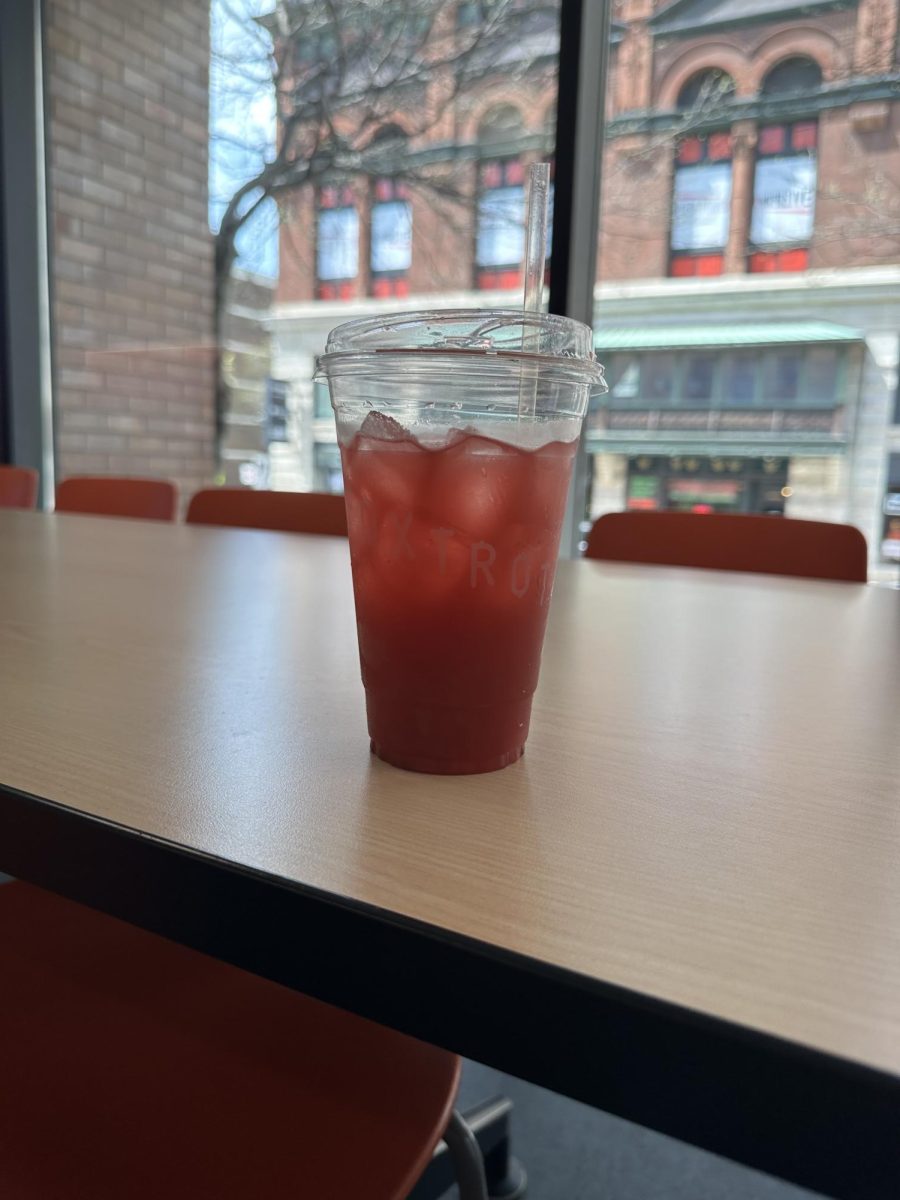Statistics Classes Rumors are usually not true. Most often, gossip has absolutely no proof. At Latin, body image, tutoring, and time spent doing homework are hotly discussed topics. Unfortunately, there has never really been any true numbers to act as evidence for these conversations. However, Ms. Dhaliwal’s AP Statistics classes and Ms. Hoying’s Statistics Graphical Display of Data classes have put their surveys to work, and have gotten real student feedback on these popular issues. Through their surveys, they have found the actual opinions of Latin students on subject matter ranging from body image to time spent relaxing. If you’re interested in the truth behind Latin’s hottest topics, look no further than these survey results. Before you begin, a word to the wise — many of these surveys suffer from nonresponse bias. What is nonresponse bias you say? Well, it is when someone is randomly selected to take a survey that takes no more than a mere minute of their time to respond to and they elect to not take it. The result? Survey findings that are based only on those who responded. What’s the problem with this? Well, it could be that the students who didn’t respond may have all answered similarly to the questions, which would greatly alter the results. Moral of the story: just take the survey! SURVEY #2 (SRS of 11 freshmen, 10 sophomores, 10 juniors) The process to add/drop a class is easy to understand. Strongly Disagree Disagree Neutral Agree Strongly Agree Narrative comments are useful to me. Strongly Disagree Disagree Neutral Agree Strongly Agree At times students at the Latin School of Chicago are unhappy with their schedules. Whether a student dislikes a single class or his entire schedule, he/she must fill out and acquire signatures on an “add-drop form.” An add-drop form requires at least 7 signatures, one from a parent and at least six from the faculty, in order to officially change a student’s classes. Do students in this school find this process difficult? To find out, we have performed three different chi-squared tests for association between students’ acceptance that the adding/dropping-of-a class process at the Latin School of Chicago is easy (which shall now be simply called “acceptance”), and an explanatory variable (gender, ethnicity, and class level). Our tests showed that the data we had showed insignificant association between “acceptance” and any of the explanatory variables. This was due, most likely, to the minimal response rate of our surveys. Of the 40 surveys that were randomly sent out to students, only 16 were sent back completed. In statistics, a decent response rate is necessary to draw conclusions, for a high response rate is more meaningful for findings regarding association than a low response rate. In statistics, a sample must pass prerequisites in order to be useful in a test. Our sample was so small that it couldn’t be used in the traditional formulae. So, we had to use another formula that didn’t have prerequisites in order to use. The data that we received from using the probabilities showed that the sample of 16 students obtained was completely insufficient. If we were to do this test again, we would strongly urge our chosen subjects (all 40) to answer the survey, rather than completely letting them forget about the survey. Our test could have shown significant data; an association between acceptance and the three explanatory variables. This test had the potential to display insight into the student satisfaction with the add-drop process. Unfortunately, because we failed to be persistent in the actual receiving of data from students, we can prove nothing. In short, students, please answer your surveys! ~Dexter Canright and Malek Samman SURVEY #3 (SRS of 11 freshmen, 10 sophomores, 10 juniors) The forms used during registration were easy to use. Strongly Disagree Disagree Neutral Agree Strongly Agree The forms used during registration were of high quality. Strongly disagree Disagree Neutral Agree Strongly Agree I looked at the electronic course catalogue during the registration process. Yes No (If yes to the previous question) The electronic course catalogue helped me make my course selections. Strongly disagree Disagree Neutral Agree Strongly Agree The survey we examined was designed to examine student responses to the course registration process. A random sample of 32 students was taken at the Latin School of Chicago, ranging in grades from freshmen to juniors. Only 16 students responded with a nonresponse rate of 50%. Our data analysis aimed to determine if there was an association between either gender, race (nonwhite vs. white), or grade level and response type to the question “Did the online course catalogue help you select your courses?” Of the four questions asked, we assumed this question would yield the most varied field of answers among the three groups. After conducting the Fisher’s Exact Probability Test, it was clear that there was no association between either gender, race, or grade level and response type to the question. All three probability tests yielded high p-values, dwarfing our alpha level 0.05, indicating that there was no association among any of the three categorical variables. It was clear that our high rate of non-response greatly affected our data. Although we cannot assume that if we had been able to deal with a full set of data from all 32 students that there would have been an instance of significance among any of the three variables, it still would have allowed us to make more precise observations about the student population. Furthermore, although we only examined one question in our probability test, it was clear from our preliminary examination of the data that none of the other questions drew any sort of varied responses among the three subcategories of respondents. Our data suggests, across the board, with minimal exception, that Latin students had a relatively easy time with the registration process. On the whole, most of them found the registration process to be straightforward and the corresponding forms easy to use and of high quality. The vast majority of them (15/16) used the online catalogue as a resource to look at class descriptions and of those 15, 14 of them alleged that it actually helped them select their courses. Again, if we administered another random sample in which there was a greater rate of response, perhaps we would have been able to make legitimate observations based on data inference. Alas, Latin students seem to be weary of surveys. ~ Sydney Bell, Oly Huzenis and Blake Lasky SURVEY #2 (SRS of 11 freshmen, 10 sophomores, 10 juniors) The process to add/drop a class is easy to understand. Strongly Disagree Disagree Neutral Agree Strongly Agree Narrative comments are useful to me. Strongly Disagree Disagree Neutral Agree Strongly Agree At times students in the Latin School of Chicago are unhappy with their schedules. Whether a student dislikes a single class, or his entire schedule, he/she must fill out and acquire signatures on an “add-drop form.” An add-drop form requires at least 7 signatures, one from a parent and at least six from the faculty, in order to officially change a student’s classes. Do students in this school find this process easy or difficult? To find out, we have performed three different chi-squared tests for association between students’ acceptance that the adding/dropping-of-a class process at the Latin School of Chicago is easy (which shall now be simply called “acceptance”), and an explanatory variable (gender, ethnicity, and class level). Our tests showed that the data we had showed insignificant association between “acceptance” and any of the explanatory variables. This was due, most likely, to the minimal response rate of our surveys. Of the 40 surveys that were randomly sent out to students, only 16 were sent back completed. In statistics, a decent response rate is necessary to draw conclusions, for a high response rate is more meaningful for findings regarding association than a low response rate. In statistics, a sample must pass prerequisites in order to be useful in a test. Our sample was so small that it couldn’t be used in the traditional formulae. So, we had to use another formula that didn’t have prerequisites in order to use. The data that we received from using the probabilities showed that the sample of 16 students obtained was completely insufficient. If we were to do this test again, we would strongly urge our chosen subjects (all 40) to answer the survey by any means, rather than letting them forget about the survey completely. Our test could have shown significant data; an association between acceptance and the three explanatory variables. This test could have really shown insight into the student satisfaction with the add-drop process. Unfortunately, because we failed to be persistent in the actual receiving of data from students, we can prove nothing. In short, students, please answer your surveys! ~Dexter Canright and Malek Samman SURVEY #3 (SRS of 11 freshmen, 10 sophomores, 10 juniors) The forms used during registration were easy to use. Strongly Disagree Disagree Neutral Agree Strongly Agree The forms used during registration were of high quality. Strongly disagree Disagree Neutral Agree Strongly Agree I looked at the electronic course catalogue during the registration process. Yes No (If yes to the previous question) The electronic course catalogue helped me make my course selections. Strongly disagree Disagree Neutral Agree Strongly Agree The survey we examined was designed to examine student responses to the course registration process. A simple random sample of 32 students was taken at the Latin School of Chicago, ranging in grades from freshman to juniors. Only 16 students responded with a nonresponse rate of 50%. Our data analysis aimed to determine if there was an association between either gender, race (nonwhite vs. white), or grade level and response type to the question “Did the online course catalogue help you select your courses?” Of the four questions asked, we assumed this question would yield the most varied field of answers among the three groups. After conducting the Fisher’s Exact Probability Test, it was clear that there was no association between either gender, race, or grade level and response type to the question “Did the online course catalogue help you select your courses?” All three probability tests yielded high p-values, dwarfing our alpha level 0.05, indicating that there was no association among any of the three categorical variables. It was clear that our high rate of non-response greatly affected our data. Although we cannot assume that if we had been able to deal with a full set of data from all 32 students that there would have been an instance of significance among any of the three variables, it still would have allowed us to make more precise observations about the student population. Furthermore, although we only examined one question in our probability test, it was clear from our preliminary examination of the data that none of the other questions drew any sort of varied responses among the three subcategories of respondents. Our data suggests, across the board, with minimal exception, that Latin students had a relatively easy time with the registration process. On the whole, most of them found the registration process to be straightforward and the corresponding forms easy to use and of high quality. The vast majority of them (15/16) used the online catalogue as a resource to look at class descriptions and of those 15, 14 of them alleged that it actually helped them select their courses. Again, if we administered another random sample in which there was a greater rate of response, perhaps we would have been able to make legitimate observations based on data inference. Alas, Latin students seem to be weary of surveys. ~ Sydney Bell, Oly Huzenis and Blake Lasky SURVEY #4 (SRS of 11 freshmen, 10 sophomores, 10 juniors, 10 seniors) Advisory time is useful to me. Strongly disagree Disagree Neutral Agree Strongly Agree My advisor encourages us to share our thoughts or opinions. Strongly disagree Disagree Neutral Agree Strongly Agree The people in my advisory make me feel like I am part of the school community. Strongly disagree Disagree Neutral Agree Strongly Agree I enjoy spending time with my advisory. Strongly disagree Disagree Neutral Agree Strongly Agree We studied the results of a survey that was given to randomly selected upper school students in grades 9-12. It asked a variety of questions regarding how people felt about advisory, as well as their gender, ethnicity, and grade level. Our survey had a 46% response rate, and therefore, it suffered from nonresponse bias. We created two-way tables for each question regarding advisory versus gender, ethnicity, or grade level. The only ones that appeared to potentially be significant were grade level vs. the usefulness of advisory, grade level vs. the enjoyability of advisory, gender vs. the usefulness of advisory, and gender vs. feeling of school community. After performing the n-1 chi-square test for each, we found there was an association between grade level and usefulness of advisory, grade level and enjoyability of advisory, and gender and the usefulness of advisory. Gender vs. feeling of school community did not have an association after the n-1 test. While under optimal circumstances, we would have a higher response rate, from these data we can conclude that grade level is associated with the way a student views the usefulness and enjoyability of advisory, and gender is also associated with the way a student views the usefulness of advisory. This implies that perhaps there is a difference in the way underclassmen and upperclassmen advisories are run, affecting the usefulness and enjoyability of advisory. Perhaps, something should be done in the administration to insure that underclassmen and lowerclassmen have equally useful and enjoyable experiences in advisory. It also appears that males and females do not profit equally from advisory, a difference that could also be addressed by the administration. Next time, answer the surveys. We will be able to draw more fascinating and exact conclusions the more people respond. Have a beautiful summer, you lovely people. P.S. Read Cherika’s article in the forum, “Cherika’s Last Stand.” ~Lexi Bonner, Charlotte Collins, and Marjorie Muller SURVEY #5 (SRS of 11 freshmen, 10 sophomores, 10 juniors, 10 seniors) Do you have a tutor or tutors? (If yes to the previous question) In which classes do your currently have a tutor? How often do you attend tutoring sessions? If you have a tutor, how often do you meet with this person? For our AP Statistics class, we wanted to see how many Latin students had tutors for various subjects and if there was a correlation between those who had tutors and the student’s age. We sent out a survey to 41 kids throughout all four grades, and received 31 responses. We were fortunate enough to have a higher than average response rate of around 75%. When we analyzed our data through a series of association tests we found that there was no association between the age of the student and whether they had a tutor. The nature of our response could have been due to the amount of responses that we obtained. We are 95% confident that the true proportion of Latin students that have a tutor is between 0.2979 and 0.4081 or roughly 30% to 41%. The subject in which students received the most tutoring was math–60%. The second most popular subject for tutoring services was standardized test preparation; 20% indicated that they were tutored in this area. ~Emma Michalak, Julian Mowatt, and Meghna Patiath SURVEY #7 (men’s and women’s health survey) (SRS of 6 freshman girls, 5 freshman boys, 6 sophomore girls, 4 sophomore boys, 6 junior girls, 4 junior boys, 5 senior girls, 4 senior boys) My appearance is important to me. Strongly disagree Disagree Neutral Agree Strongly Agree In the past I have changed my eating habits to change my appearance. Strongly disagree Disagree Neutral Agree Strongly Agree I compare my body to that of others. Strongly disagree Disagree Neutral Agree Strongly Agree I am satisfied with my body weight. Strongly disagree Disagree Neutral Agree Strongly Agree Over the last few issues of the forum, body image has been a hotly discussed topic. Our statistics teacher carried out a survey asking students at Latin questions regarding their body image and we compared the data to age and gender. We wanted to know if how one views their body at Latin is related to their age or gender. Our results do not show any correlation between if one compares their body to that of others and gender or age. Age and gender also had no correlation between satisfaction with body weight or whether someone changed their eating habits to change their appearance. All of the questions were posed to Latin high school students and can only be used to make statements about the Latin student high school community. From our data we can infer that worries about one’s own body image exist in generally the same proportions across age and gender. However, there was a substantial non-response rate. Only 24 out of 40 responded. It is possible that those who did not respond felt less secure about their bodies. 10 out of 17 boys responded, while 14 out of 23 girls responded meaning that the non-response rate was almost exactly the same between boys and girls. 15 out of 21 underclassmen responded while only 9 out of 19 upperclassmen responded. Therefore, we have more confidence that gender and feelings about one’s body are not related than we can with age and feelings about one’s body. While we can’t infer anything from data that doesn’t exist, the high non-response rate could be attributed to apathy or insecurities about their body image. Yet, people that are confident about their bodies might not think about it as much and be more inclined to ignore the survey. So the high non-response rate could go both ways. To conclude, no association was found between age or gender with views of one’s body. These results may come as a surprise to some that consider worries about one’s body to be more prevalent among girls. While the survey didn’t address many related issues such as eating disorders, it hopefully will allow us to have a more accurate view of how members of our community feel about their bodies. ~Josh Goldberg, Will Pritzker, and Kobi Walsh Statistical analysis by our peers revealed no association between body image and gender, so we set out to find an estimate of how the population at Latin felt about their body image. We sent out a survey with four statements in which students, from graduating years 2013 to 2016, were asked to respond. The survey was sent to 40 randomly selected students. Only 24 responded, which means our nonresponse rate was nearly 50%. In our study, based on the confidence intervals we performed, we are 95% confident that the true proportion of students that agreed/strongly agreed that they compare their bodies to others falls between 43% and 82% and the true proportion of students that agreed/strongly agreed to being satisfied with their weight falls between 29% to 70%. Lastly, we are 95% confident that the true proportion of students that agreed/strongly agreed that they changed their eating habits in the past to change their appearance was between 34% and 74%. Because these intervals are all wide, they are less meaningful because there are many possibilities for the true proportion of students that agreed/strongly agreed to any of the statements. And therefore, our results reveal that we are 95% confident at least 43% of students compare their bodies to others, at least 29% are satisfied with their body weight, and at least 34% have changed their body in the past to change their appearance. ~Arjah’Nay Herron, Blair Marshall, and Anel Vaca SURVEY #8 (anyone) (43 randomly selected across all grades) Of the 16 hours you had between the end of school yesterday and the start of school today: How much time did you spend on homework? How much time did you spend on sports/clubs/extracurriculars? How much time did you spend relaxing? How much time did you spend sleeping? We were interested in examining how much time students spent after school engaged in extracurricular activities and the amount students slept. We also wanted to test if certain groups were significantly different from one another (i.e. upperclassman vs. lowerclassman, male vs. female, and white vs. non-white). We then put them up against two quantitative variables: hours those students spent sleeping and hours those students spent on extracurricular activities, such as sports and clubs. We took a random sample of 43 students in the upper school and of those 21 responded. This revealed to us a .51 non-response rate, which is significantly high. When we stated our original hypothesis, we said that the true population mean for the two categorical variables is the same, with our alternative stating the opposite. After we conducted our tests, we found that there was no difference between any of the groups in terms of how much time they spent after school engaged in extracurricular activities or sleeping. ~ Ryan Lewis, Leland Markman, and Ben Sullivan Survery # 9 As the 2012-2013 year comes to a close, and in the midst of final papers and exams galore, Ms. Dhaliwal’s AP Statistics classes took a look into Latin’s student body to understand more about our behaviors and habits. Students were randomly selected to fill out various surveys anonymously, to provide insight into the lives of the average Latin High School student. Specifically, our group’s survey asked respondents to report the number of hours students spent working on homework and relaxing during the 16 hours after school and before it began the following morning. So, our question is, do these actions differ based upon a student’s gender, ethnicity, or grade level? Keep reading to find out. Our findings are as follows: we fail to conclude that upper and underclassmen spend significantly different amounts of time on their homework. Similarly, we cannot conclude that the mean time spent on homework nightly by male and female students is not equal. Next, we studied the median number of hours students spent relaxing in the 16 hours after school and before it began the next morning. Leading us to conclude that there is no difference between grade level in time spent relaxing. We can also conclude that there is no difference between time spent relaxing by ethnicity. However, we can conclude that men and women at Latin spend different amounts of time relaxing. We are 95% confident that men spend between 2.8 and 4.2 hours relaxing and women spend between 1.2 and 2.3 hours relaxing. ~Megan Foler, Conley Pollard, and Marissa Weiss SURVEY #10 (anyone) (SRS of 43 across all grades) How many times have you spoken / performed at gathering this year. Last week we had a clubs’ block. Did you attend a club meeting last week? YES/NO Phat Stats For our first project, we decided to test whether a person’s ethnicity had any effect on how many times that person has spoken at gathering. In our data set, about half the people were white and the other half were non-white. We decided to construct a 95% confidence interval for the true median number of times spoken among whites and non-whites separately. A 95% confidence interval helps us estimate the true medians without actually testing everyone in the population. As a result of Yaodi’s hard work and long nights hacking away at the computer, we can say with 95% confidence that the true median of times spoken at gathering among whites is between -0.18 and 0.18. A negative number of times spoken is impossible, though, so the more accurate interval would be between 0 and 0.18. Thanks Yaodi. True determination, that guy. Then Yaodi did another interval for non-whites. We can conclude with 95% confidence that the true median of times spoken at gathering among non-whites is between 0 and 2.24. Although this interval is a lot wider than the white’s interval, Youdi says the difference is not significant enough to conclude that there is an association between race and number of times spoken at gathering because the intervals overlap, and I believe him. Also, our sample size was fairly small, so we didn’t have a lot of power to make a conclusive conclusion (see what I did there?). In comes Matt. Matt wanted to find out whether a person’s gender had an influence on whether they went to a club during a clubs block. He constructed a chi-square test for association/independence rather skillfully to test whether there was a significant difference in the proportions of people who went to clubs block between males and females. He retitled everyone’s gender as “male” and “female” so the table could be more organized. In the end, he found that the data is not statistically significant enough to conclude that if there is an association between a person’s gender and whether that person went to a club during clubs block. So after all our hard work, we were unable to come up with anything ground-breaking. We can’t conclude that ethnicity is associated with how many times someone speaks at a gathering, and we can’t conclude that gender is associated with whether or not someone goes to a club during clubs block. Riveting stuff. ~Jonah Glick, Yaodi Hu, Matt Rauner SURVEY #11 (anyone) (SRS of 43 across all grades) Rank these subjects in order of favorite to least favorite: English, History / Social Studies, Language, Math, Performing Arts, Physical Education, Science, Visual Arts Rank these subjects in order of most difficult to least difficult: English, History / Social Studies, Language, Math, Performing Arts, Physical Education, Science, Visual Arts The goal of our research was to study whether class difficulty was associated with the class’ popularity. In addition, we examined whether there is an association between gender and class preference. We studied the results of a simple random sample of 43 students, ranging from freshmen to seniors, and both male and female. Students were emailed and told about the study and those who chose to participate followed the e-mail’s instructions to answer an online survey. However, due to the high rate of nonresponse, only 25 participated in the survey and thus 42% did not respond. One of our results revealed that there might be an association between English/History and gender. After performing a significance test, we found that females tended to favor English and History more than males. We also found that there is no association between gender and a preference for math and science. This may be particularly interesting because many students typically think that men prefer math more than women due to the high proportion of men that are in high-level math classes such as Multivariable Calculus. For the last four years, there have been three or less girls in in high-level science classes like AP Physics. Although many students may conceive high level mathematics courses to be dominated by males, this fact does not prove that males favor the subject over women. While our findings have surprised and intrigued many, it is important to note that some results may be insignificant due to nonresponse error. It would be interesting to repeat the study with the same sample size as long as long as there is no nonresponse. ~Lita Araysi, Gaby Dago, and Lana Ifergan SURVEY #12 (SRS of 10 juniors and 10 seniors) I plan to keep in touch with Latin after I graduate. Strongly Disagree Disagree Agree Strongly Agree If you had to declare a college major right now, what would it be? One of my main criteria for choosing a college is its ranking in the U.S. News and World Report. Strongly Disagree Disagree Agree Strongly Agree Do students plan on keeping in touch with Latin after graduation? How important are college rankings to Latin upperclassmen? These are the questions our AP Statistics survey sought to find out. There are many assumptions made about Latin students and their behavior, so the purpose of our final project in AP Statistics was to bust some myths, or even confirm some. We surveyed 20 randomly-selected upperclassmen, 10 juniors and 10 seniors, and were able to obtain a 100% response rate. Here are the results. Latin has opened many new doorways for most of us over the time we have spent here. From being a source for networking to being a place that might have helped us discover a passion, there are many different reasons that would make people want to stay in touch with Latin. So, do most students want to stay connected to the Latin community after graduation? By statistical analysis, we are 95% confident that the true proportion of Latin upperclassman who agree they will keep in touch with Latin after graduating is between .141 and .559. So, about 14-55% of juniors and seniors want to keep in touch with Latin after graduation. After graduation, the next phase in our lives is college. It seems impossible to get away from this looming cloud that hovers closer and closer to us as the years progress in high school. There is a lot of pressure associated with this process, and this period of stress is almost seen as a right-of-passage. When talking about college we are dealing with our future, something not to me messed around with, and it is only natural that we deal with some level of concern and worry. However, are we choosing colleges because our personalities and desires match up with a college, or because it is ranked as one of the top schools in the country? Through another statistical analysis, we are 95% confident that the true proportion of Latin upperclassman who agree that college ranking is important when choosing colleges is between .185 and .615. Basically, about 20-60% of juniors and seniors think that college ranking has a significant influence over their college decisions. In the end, some students do plan to keep in touch with Latin after graduation, and a notable amount believe college ranking is an important factor when choosing colleges. ~Nicole Heckman, Simonne Nettles, and Amanda Orenstein ]]>
Categories:
Myth Busting: Latin Statistic Classes Reveal Their Findings
June 3, 2013
1
0
More to Discover




















































jreiner • Jun 4, 2013 at 9:30 pm
I would love to see just a comprehensive, simple table with the results of the surveys, so that way I can see the results of the surveys right off the bat and then I can read about it if I have a chance. Great work and very interesting – I’m looking forward to these classes!